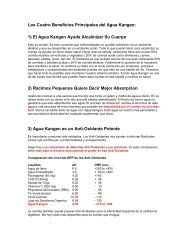ACID-ALKALINE BALANCE: ROLE IN CHRONIC ... - My Kangen Tools
ACID-ALKALINE BALANCE: ROLE IN CHRONIC ... - My Kangen Tools
ACID-ALKALINE BALANCE: ROLE IN CHRONIC ... - My Kangen Tools
You also want an ePaper? Increase the reach of your titles
YUMPU automatically turns print PDFs into web optimized ePapers that Google loves.
338 Y.-R. Huang et al. / Food Control 19 (2008) 329–345<br />
Table 3 (continued)<br />
Vegetables Immersion condition Indicator Effectiveness EO water property Ref.<br />
pH ORP (mV) Free chlorine (mg/L) Temperature (°C)<br />
++ 2.4 1081 84 23 Kim et al. (2003)<br />
Alfalfa seeds 3 hr Non-Salmonella<br />
microflora<br />
Alfalfa sprouts 10 min EO & sonication Salmonella sp. ++ 2.4 1081 84 23 Kim et al. (2003)<br />
Alfalfa sprouts 10 min EO & sonication Non-Salmonella + 2.4 1081 84 23 Kim et al. (2003)<br />
microflora<br />
Alfalfa sprouts 10 min EO & seed coat removal Salmonella sp. ++ 2.4 1081 84 23 Kim et al. (2003)<br />
Alfalfa sprouts 10 min EO & seed coat removal Non-Salmonella ++ 2.4 1081 84 23 Kim et al. (2003)<br />
microflora<br />
Alfalfa sprouts 10 min EO & sonication & seed coat Salmonella sp. +++ 2.4 1081 84 23 Kim et al. (2003)<br />
removal<br />
Alfalfa sprouts 10 min EO & sonication & seed coat removal<br />
Non-Salmonella microflora<br />
++ 2.4 1081 84 23 Kim et al. (2003)<br />
Alfalfa seeds 15 min EO Salmonella sp. ++ 2.5 1079 70 23 Stan and Daeschel<br />
(2003)<br />
Alfalfa seeds 60 min EO Salmonella sp. ++ 2.6 1076 66.8 23 Stan and Daeschel<br />
(2003)<br />
++++, bacterial reduction being more than 4 log CFU/ per unit; +++, bacterial reduction being between 2 and 4 CFU/ per unit; ++, bacterial reduction being between 1 and 2 CFU/ per unit;<br />
+, bacterial reduction being less than 1 log CFU/ per unit. –, not measured.<br />
ER water (pH of 11.3, ORP of 870 mV) for 5 min and<br />
then soaked in EO water (pH of 2.6, ORP of 1130 mV<br />
and free chlorine of 30 mg/L) for 5 min showed a reduction<br />
in aerobic mesophiles. This treatment had at least<br />
2 logCFU per cucumber greater reduction than that only<br />
soaked in EO water (30 mg/L free chlorine), ozonated water<br />
(5 mg/L ozone) or sodium hypochlorite solution (NaOCl,<br />
150 mg/L free chlorine) for 10 min. In studies on sequential<br />
wash treatment, Koseki et al. (2001) also found that a 2-<br />
logCFU/g reduction in aerobic bacteria counts for both<br />
the lettuce treated with ER water for 1 min followed by<br />
the treatment with EO water for 1 min and the lettuce treated<br />
with acidic EO water alone for 10 min; however,<br />
repeated EO water treatment did not show a significant<br />
increase of bacterial reduction. Koseki et al. (2004c) used<br />
mildly heated (50 °C) ER water to treat lettuce for 5 min,<br />
and then used chilled (4 °C) EO water to treat for 1 or<br />
5 min. They found the treatment could reduce both E. coli<br />
O157:H7 and Salmonella at a level of 3–4 logCFU/g.<br />
Wang, Feng, and Luo (2004) washed fresh-cut cilantro with<br />
ozonated water for 5 min followed with a EO water (pH of<br />
2.45, ORP of 1130 mV and free chlorine of 16.8 mg/L) for<br />
5 min and found that the sequential wash is effective in<br />
reducing initial microbial count and slowing microbial<br />
growth during storage.<br />
Lettuce with smooth surfaces have been used for the<br />
investigation of the effectiveness of EO water on bacterial<br />
reduction. Park et al. (2001) observed that shaking lettuce<br />
with EO water (45 mg/L free chlorine) at 100 rpm for 3 min<br />
significantly decreased mean populations of E. coli<br />
O157:H7 and L. monocytogenes by 2.41 and 2.65 logCFU<br />
per lettuce leaf, respectively, when compared with sterile<br />
H 2 O treatment. The result was in agreement with that of<br />
Izumi (1999) who pointed out that EO water (50 mg/L of<br />
free chlorine) treatment of shredded lettuce did not significantly<br />
affect the quality characteristics such as color and<br />
general appearance. Yang et al. (2003) suggested that<br />
fresh-cut lettuce dipped in EO water (pH 7) containing<br />
300 mg/L of free chlorine for 5 min could not only keep<br />
the best visual quality but also achieve a 2-log CFU/g<br />
reduction for S. Typhimurium, E. coli O157:H7 and<br />
L. monocytogenes.<br />
Koseki and Itoh (2001) suggested that the best temperature<br />
for distribution of fresh-cut vegetables with reduced<br />
microbial population is 1 °C. Ice is an inexpensive material<br />
for preserving fresh produces and fish. Koseki, Fujiwara,<br />
and Itoh (2002) treated lettuce with frozen EO water (pH<br />
of 2.5, ORP of 1148 mV and free chlorine of 20.5 mg/L)<br />
and stored in a styrene-foam container for 24 h. The results<br />
indicated that a 1.5-log CFU/g aerobic bacteria counts<br />
reduction on lettuce was due to an increased chlorine gas<br />
concentration from frozen EO water. In order to check<br />
the effectiveness of Cl 2 concentration and volume or weight<br />
ratio of vegetables to frozen EO water, Koseki, Isobe, and<br />
Itoh (2004a) prepared a EO-ice by freezing EO water at<br />
40 °C. The EO water with 20, 50, 100 and 200 mg/L of<br />
free chlorine could generate ice with 30, 70, 150 and



